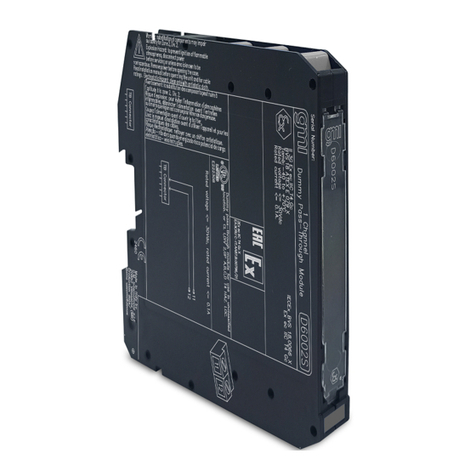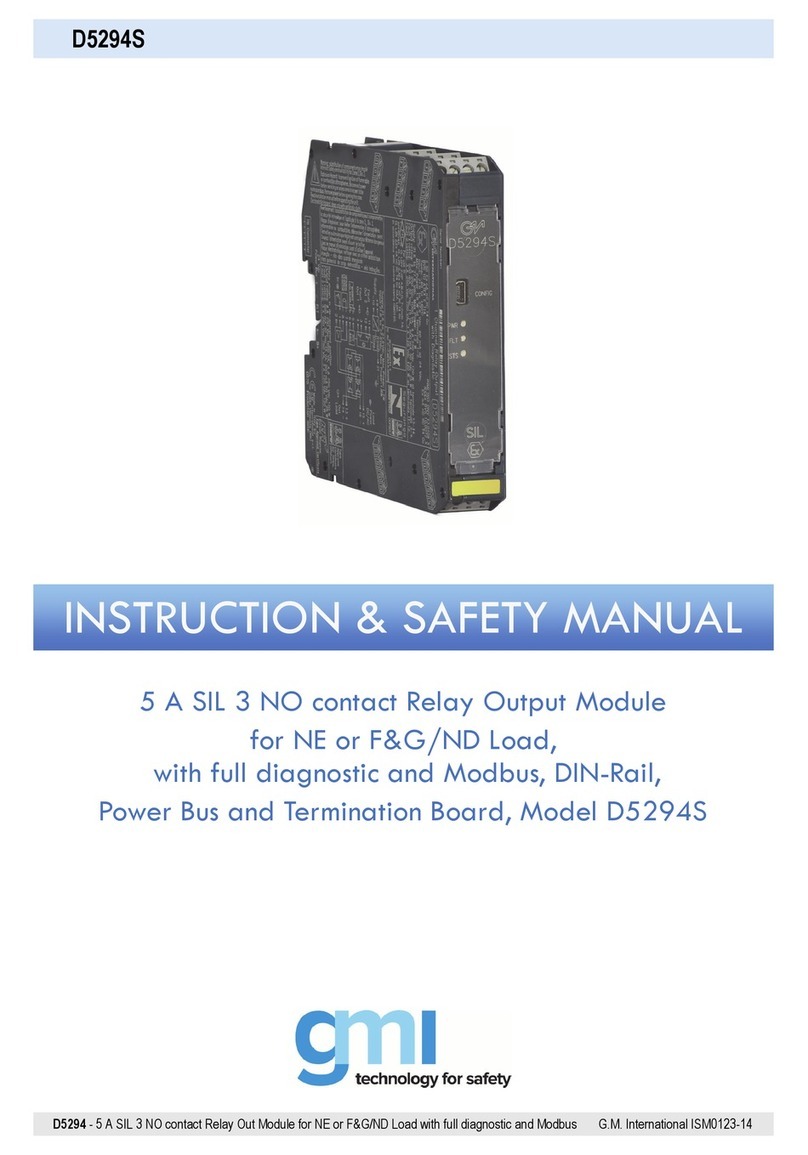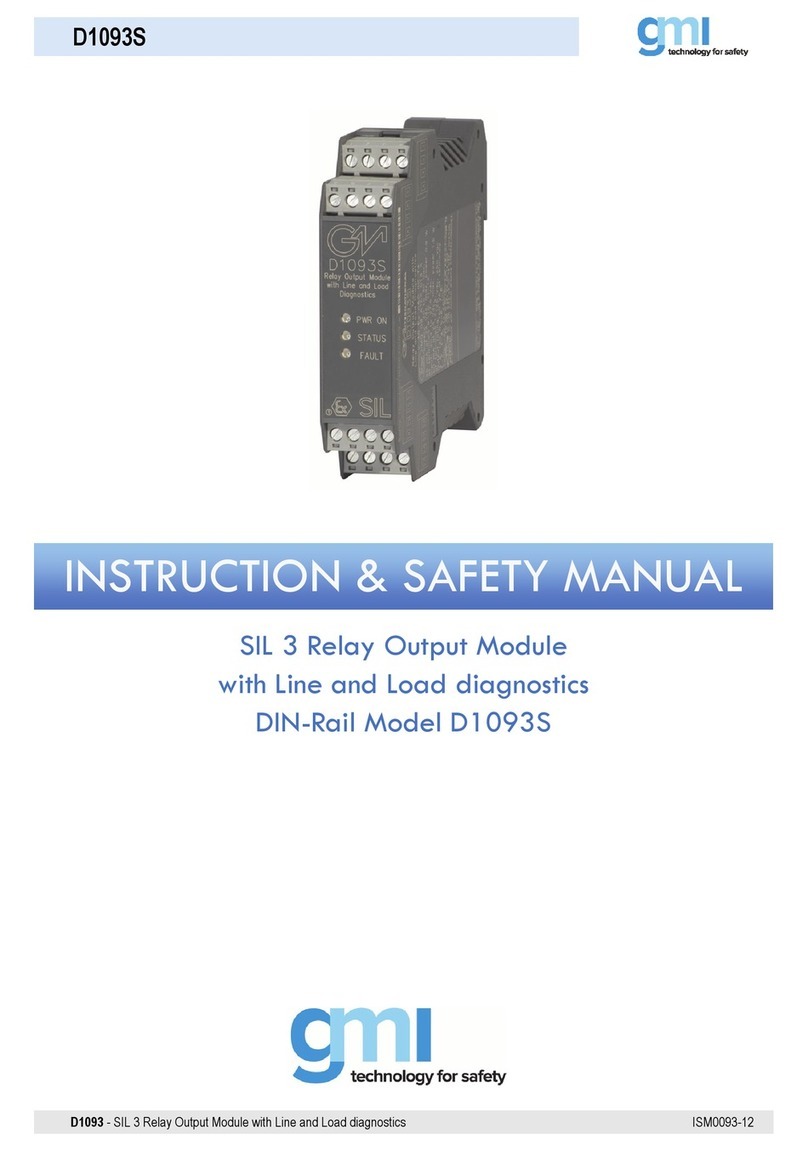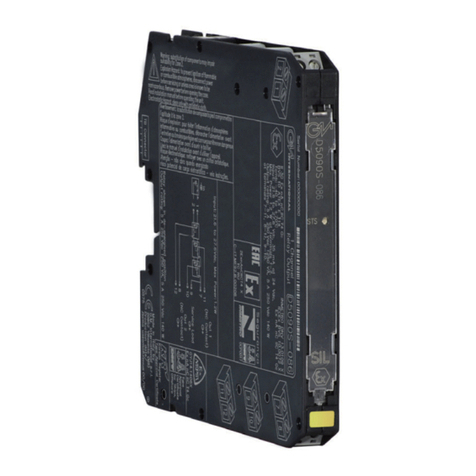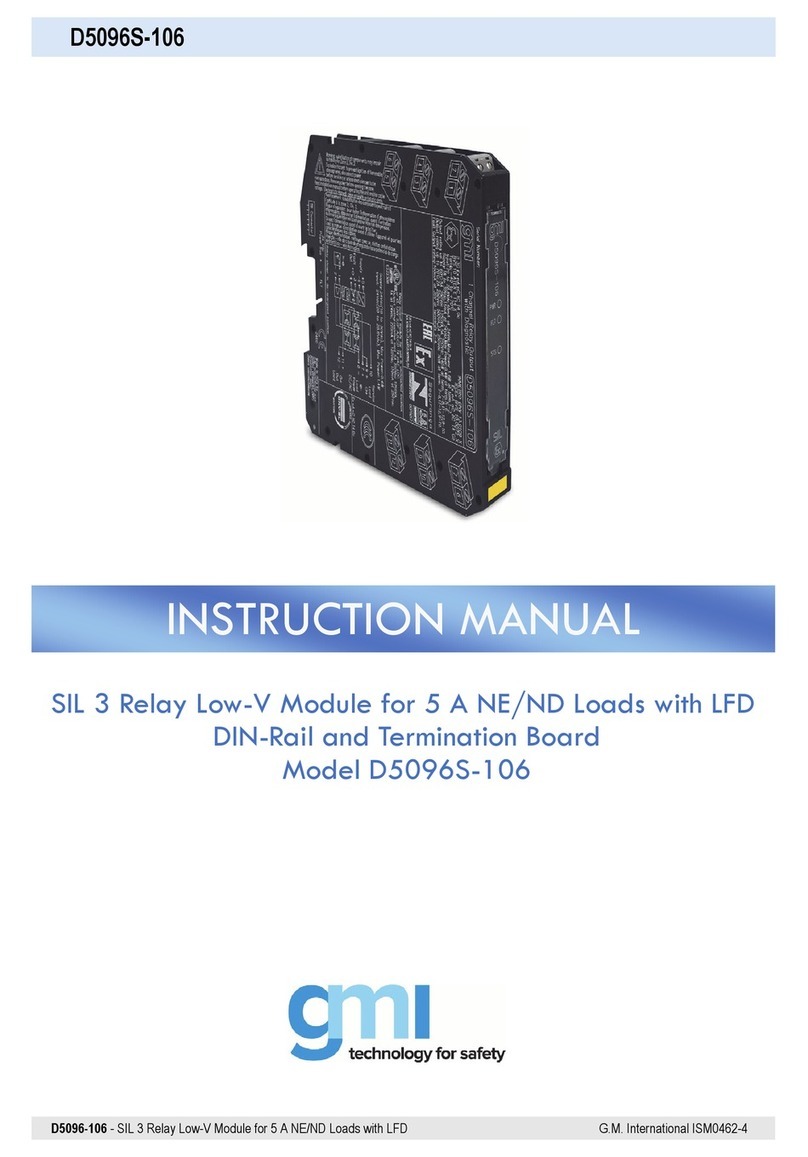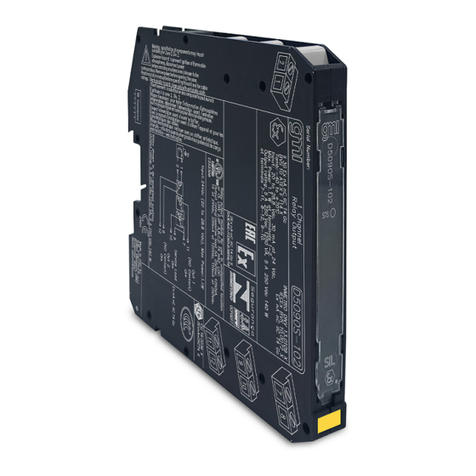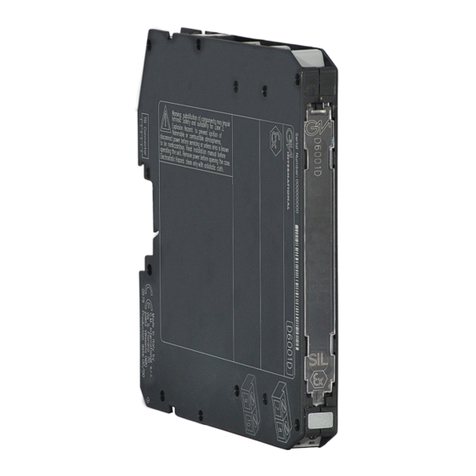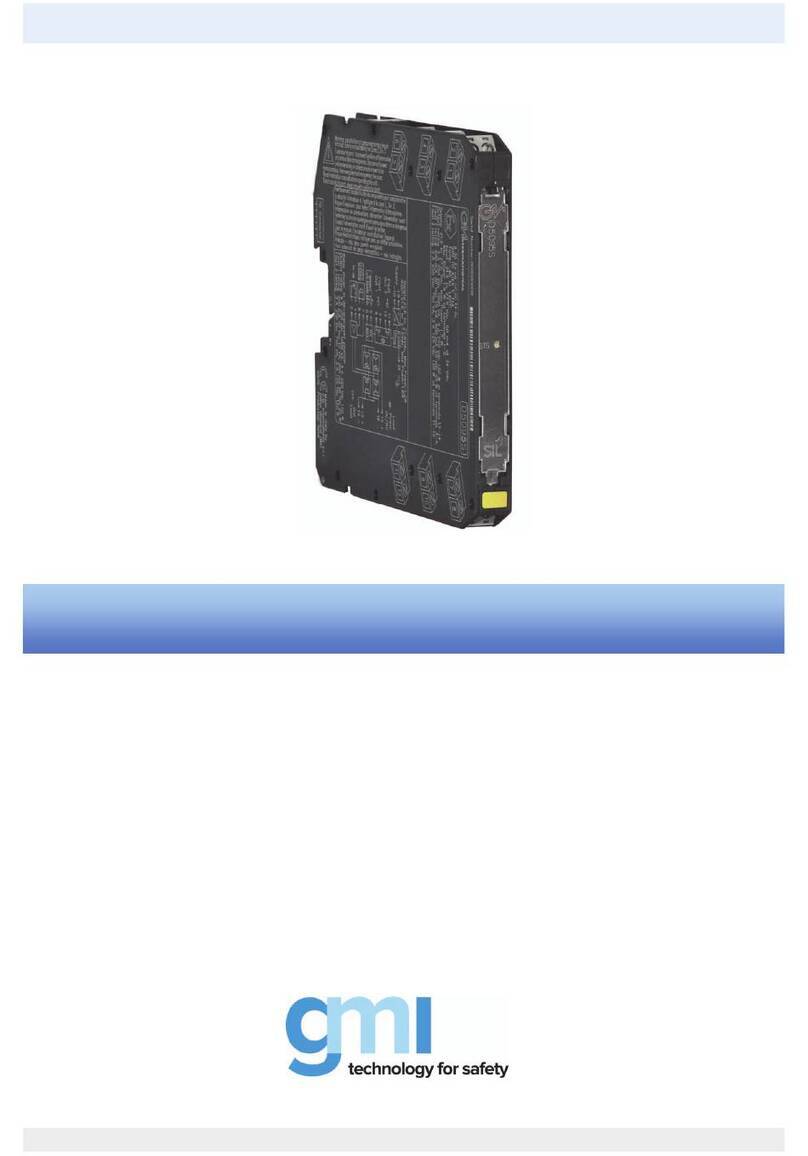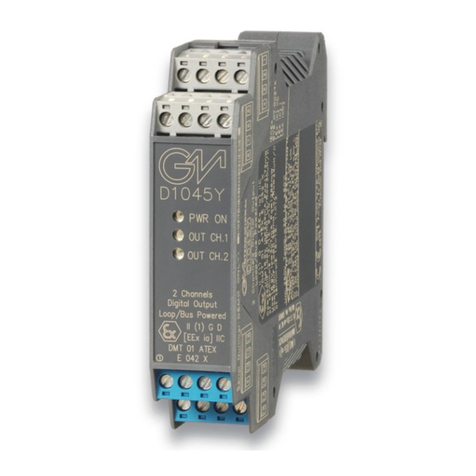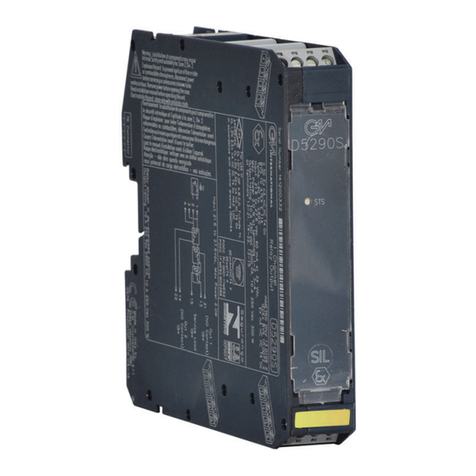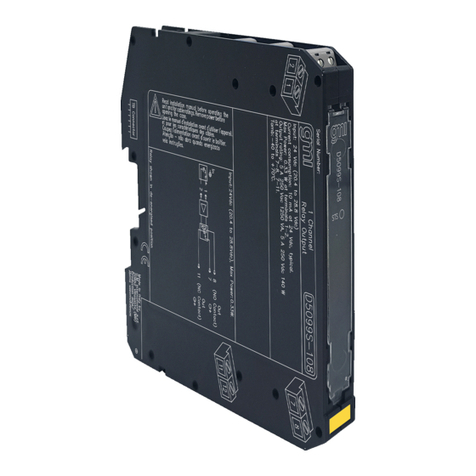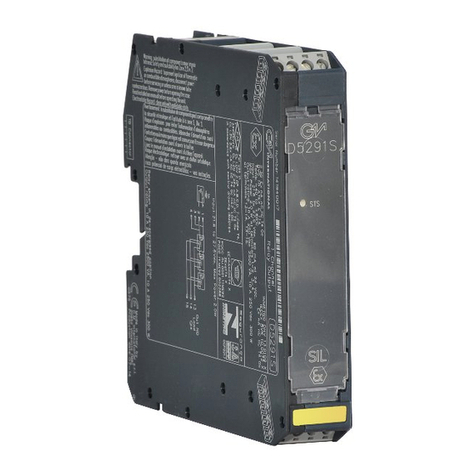
7
D5090 - 5 A SIL 3 Relay Output Module for NE LoadG.M. International ISM0109-16
The proof test shall be performed to reveal dangerous faults which are undetected by diagnostic. This means that it is necessary to specify how dangerous undetected faults, which
have been noted during the FMEDA, can be revealed during proof test. The Proof test consists of the following steps:
Testing procedure at T-proof
Steps Action
1Bypass the safety-related PLC or take other appropriate action to avoid a false trip when removing the unit for test.
2For the single channel, verify the input-to-output functionality:
the output load is normally energized by supplying the input channel, while shutdown of the input channel de-energizes the load (safe state).
The channel functionality must be verified for a min to max input voltage change (21.6 to 27.6 Vdc).
In addition, the use of three relays for the single output channel, where the contacts are connected in series, requires to control the single coil by means of
DIP-switches (n°1, 3, 5) and to check the ohmic continuity of the contacts, as described in the following procedure.
1. Do not supply the input channel (terminals “1”-“2”) of the unit under test and verify that the ohmic continuity at the Out 1 and Out 2 contacts (terminals
“7”-“11” and “8”-“12”) is absent (i.e. both the Out 1 contact (series connection of two relay contacts) and the Out 2 contact are open: 1st requisite is
verified). For Out 1 contact, this condition could also be true if only one of two relay contacts in series is open and other is blocked (for welding) into
closed or open position: this will be verified by testing the channel when input is supplied, as described in the point 3 of the procedure.
Instead, the presence of ohmic continuity at the Out 1 implies that both relay contacts in series are blocked (for welding) into closed position, while
the presence of ohmic continuity at the Out 2 implies that the relay contact is blocked (for welding) into closed position.
2. Supply the input channel (terminals “1”-“2”) of the unit under test and verify that the ohmic continuity at the Out 1 and Out 2 contacts (terminals “7”-“11”
and “8”-“12”) is present (i.e. both the Out 1 contact (series connection of two relay contacts) and the Out 2 contact are closed: 2nd requisite is verified).
The absence of ohmic continuity at the Out 1 contact implies that one of two relay contacts in series is blocked (for welding) into open position: this could
only be verified disassembling and individually testing each of two relay contacts. Instead, the absence of ohmic continuity at the Out 2 contact implies
this relay contact is blocked (for welding) into open position.
3. Always supplying the input channel (terminals “1”-“2”) of the unit under test, to verify if one of two relay contacts in series (Out 1) is blocked (for welding)
into closed position, use internal DIP-switches (n°1 and 3) to put in short circuit one relay coil at a time (starting with the 1st coil by DIP-switch n°1, then
going on with the 2nd one by DIP-switch n°3), verifying that the ohmic continuity is always absent between terminals “7”-“11”. The presence of ohmic
continuity implies that a relay contact (the only one with de-energized coil) is blocked (for welding) into closed position.
3Remove the bypass from the safety-related PLC or restore normal operation inserting the unit.
This test reveals almost 99% of all possible Dangerous Undetected failures in the relay module.
Warning
Operation
D5090S relay module is suitable for the switching of safety related circuits, providing isolation between the input and output contacts.
D5090S provides two NO contacts for normally energized load and a NC contact for service purpose, in order to switch the NE load on both supply lines.
See the previous pages for Functional Safety applications with related SIL value.
A “RELAY STATUS” yellow led lights when input is powered, showing that relay is energized.
Installation
D5090 series are relay output module housed in a plastic enclosure suitable for installation on EN/IEC60715 TH 35 DIN-Rail or on customized Termination Board.
D5090 series can be mounted with any orientation over the entire ambient temperature range.
Electrical connection are accommodated by polarized plug-in removable screw terminal blocks which can be plugged in/out into a powered unit without suffering or causing any damage
(for Zone 2 installations check the area to be nonhazardous before servicing). Connect only one individual conductor per each clamping point, use conductors up to 2.5 mm²
(13 AWG) and a torque value of 0.5-0.6 Nm. For USA and Canada installations, use only cables that are suitable for a temperature of at least 85°C. The wiring cables have to be
proportionate in base to the current and the length of the cable.
In case of installation in zone 2, the connecting cables of non-intrinsically safe circuits must be safely routed in a cable duct or similar. The distance between the pluggable connection
terminal and the cable duct should not exceed 500 mm cable length.
On the section “Function Diagram” and enclosure side a block diagram identifies all connections.
Identify the function and location of each connection terminal using the wiring diagram on the corresponding section, as an example:
Connect positive input at terminal “1” and negative input at “2”.
Connect positive or AC load supply line to CM1 Common pole (terminal “7” (for SIL 3 NE load) or “9” (for Not SIL Service Load)).
Connect SIL 3 Normally Energized (NE) Load at terminal “11” and “12”.
Connect negative or AC load supply line at terminal “8” (for SIL 3 NE load).
Connect Not SIL Service Load at terminal “10” and to negative or AC load supply line.
Installation and wiring must be in accordance to the relevant national/international installation standards (e.g. EN/IEC60079-14 Electrical apparatus for explosive gas atmospheres -Part
14: Electrical installations in hazardous areas (other than mines)), make sure that conductors are well isolated from each other and do not produce any unintentional connection.
Connect load relay contacts checking the load rating to be within the contact maximum rating (5 A 250 Vac 1250 VA, 5 A 250 Vdc 140 W resistive load).
To prevent relay contacts from damaging, connect an external protection (fuse or similar), chosen according to the relay breaking capacity diagram from installation
instructions.
The enclosure provides, according to EN60529, an IP20 minimum degree of protection (or similar to NEMA Standard 250 type 1). The equipment shall only be used in an area of at least
pollution degree 2, as defined in IEC 60664-1. When installed in EU Zone 2, the unit shall be installed in an enclosure that provides a minimum ingress protection of IP54 in accordance
with IEC 60079-0. When installed in a Class I, Zone 2 Hazardous Location, the unit shall be mounted in a supplemental AEx or Ex enclosure that provides a degree of protection not less
than IP54 in accordance with UL/CSA 60079-0. When installed in a Class I, Division 2 Hazardous Location, the unit shall be mounted in a supplemental enclosure that provides a degree
of protection not less than IP54. The enclosure must have a door or cover accessible only by the use of a tool. The end user is responsible to ensure that the operating temperature of
the module is not exceeded in the end use application. Units must be protected against dirt, dust, extreme mechanical (e.g. vibration, impact and shock) and thermal stress, and casual
contacts. If enclosure needs to be cleaned use only a cloth lightly moistened by a mixture of detergent in water.
Electrostatic Hazard: to avoid electrostatic hazard, the enclosure of D5090 series must be cleaned only with a damp or antistatic cloth.
Any penetration of cleaning liquid must be avoided to prevent damage to the unit. Any unauthorized card modification must be avoided.
All circuits connected to D5090 series must comply with the overvoltage category II (or better) according to EN/IEC60664-1.
Warning: de-energize main power source (turn off power supply voltage) and disconnect plug-in terminal blocks before opening the enclosure to avoid electrical shock
when connected to live hazardous potential.
D5090 series are electrical apparatus installed on standard EN/IEC60715 TH 35 DIN-Rail located in Safe Area/Non Hazardous Locations or Zone 2, Group IIC T4 or Class I, Division 2,
Group A, B, C, D, T4 Hazardous Area within the specified operating temperature limits Tamb - 40 to +70 °C.
D5090 series must be installed, operated and maintained only by qualified personnel, in accordance to the relevant national/international installation standards (e.g. IEC/EN60079-14
Electrical apparatus for explosive gas atmospheres - Part 14: Electrical installations in hazardous areas (other than mines)), following the established installation rules. De-energize
power source (turn off power supply voltage) before plug or unplug the terminal blocks when installed in Hazardous Area or unless area is known to be nonhazardous.
Warning: substitution of components may impair suitability for Zone 2/Division 2. Avertissement: la substitution des composants peut nuire à l’aptitude à la Zone 2/Div. 2.
Explosion Hazard: to prevent ignition of flammable atmospheres, disconnect power before servicing or unless area is known to be nonhazardous. Danger d'Explosion: pour
éviter l’inflammation d’atmosphères inflammables, débrancher l’alimentation avant l’entretien ou à moins que région est connue pour être non dangereuse.
Warning: de-energize main power source (turn off power supply voltage) and disconnect plug-in terminal blocks before opening the enclosure to avoid electrical shock
when connected to live hazardous potential. Avertissement: débrancher l’alimentation (couper la tension d'alimentation) et les blocs de jonction enfichables avant d’ouvrir
le boîtier pour éviter les chocs électriques lorsqu’ils sont connectés à un potentiel dangereux.
Failure to properly installation or use of the equipment may risk to damage the unit or severe personal injury.
The unit cannot be repaired by the end user and must be returned to the manufacturer or his authorized representative. Any unauthorized modification must be avoided.
